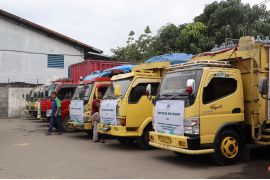Maria was not only considered the oldest Hajj pilgrim from Indonesia but also the most elderly in the world during the last Hajj season. Upon arrival at King Abdulaziz International Airport, Jeddah, Maria was greeted by the Director of Operations at the Ministry of Culture and Information of Saudi Arabia, Abdulkhaliq Al-Zaharani; the Indonesian Consular in Jeddah, Mohammed Sharif Deen; and the Head of Indonesian Hajj Mission, Arshad Hadia; as well as journalists from Saudi Arabia's news agencies and television stations who covered her arrival.
Maria was one of the 221 thousand Indonesian pilgrims who had the opportunity to worship in the Holy Land in 2017/1438 Hijri.
The Hajj, which is conducted annually in a specific month according to the Islamic calendar, is the duty of every Muslim. The pilgrims go to Mecca, the holiest city for Muslims, and carry out several rituals. Hajj is done at least once in a lifetime by all adult Muslims who are physically and financially capable of undertaking the journey and supporting their family during their absence.
The Hajj rituals can be performed at any time, which is called umrah.
The challenge of fulfilling one of the five pillars of Islam starts from the time a candidate pilgrim is still in his/her country, as they have to wait for the time of departure for tens of years.
The growing number of Muslim population in the world is directly in line with the number of pilgrims, especially from countries with Muslim majority, such as Indonesia. This condition requires the Government of Saudi Arabia to establish a quota system so that the implementation of the worship can be carried out well, including when the pilgrims are in the Holy Land.
According to the system, the number of pilgrims differs in each country with Muslim population, with the formula of one thousand pilgrims per 1 million Muslims per country.
Data from the Statistics Central Agency (BPS) 2017 showed that the number of Muslims in Indonesia was 228,608,665 people. With the quota formula set by the Saudi Government during the Hajj season 2017, the number of pilgrims from Indonesia reached 221 thousand people.
Al Jazeera listed Indonesia as the country with the largest pilgrims in the world, followed by Pakistan, with 179,210 worshipers; India, with 170 thousand pilgrims; Bangladesh, with 127,198 pilgrims; Egypt, with 108 thousand pilgrims; Iran, with 86.5 thousand pilgrims; Nigeria, with 79 thousand pilgrims; Turkey, with 79 thousand pilgrims; Algeria, with 36 thousand pilgrims; and Morocco, with 31 thousand pilgrims.
Although the Hajj quota for Indonesia in 2017 increased by 10 thousand compared to that of the previous Hajj season, the waiting period for Hajj pilgrims is still very long.
The Indonesian Ministry of Religious Affairs stated that until Feb 2017, the longest waiting period for Hajj pilgrims was South Sulawesi, of 29 years; followed by South Kalimantan, of 28 years. Meanwhile, the prospective pilgrims from West Java, Bengkulu, West Kalimantan, and Maluku should wait for 14 years before they can go to the Holy Land. Meanwhile, the shortest waiting period is North Sulawesi, which is 11 years.
Vision 2030
Saudi Arabia could be the biggest event organizer in the world, as the government, headed by King Salman bin Abdulaziz Al Saud, welcomes and serves millions of Muslims worldwide who perform Hajj and umrah throughout the year.
In 2017/1438 Hijri season, about 2.35 million Muslims around the world gathered in the Haram Land. They reached the Holy Land by air, land, and sea to fulfill their obligations as Muslims.
Throughout the year, the birth place of Prophet Muhammad (peace be upon him) is never deserted as more Muslims visit the Grand Mosque in Mecca and Nabawi Mosque in Madinah (about 460 kilometers from Mecca) to worship, as well as make a tour to various historic places of Islam.
The Saudi Arabian Ministry of Culture and Information remarked that Hajj and umrah, as well as services to pilgrims, are the main priorities and a continuing role of the government for Muslims around the world.
Therefore, the Kingdom of Saudi Arabia, under the leadership of King Salman who is the Guardian of Two Holy Mosques (Masjidil Haram and Masjid Nabawi), has done the greatest expansion of the Grand Mosque throughout the Islamic history.
The effort is expected to increase the number of Hajj and umrah pilgrims to 30 million people by 2039. This plan stems from the success of the Saudi Government in managing the largest umrah season, allowing nearly 6.5 million people from around the world to worship in the Holy Land.
The plan is also included in the Vision Saudi Arabia 2030, which was introduced by the Crown Prince, Prince Mohammad bin Salman.
The Vision 2030 will change the face of Saudi Arabia to be more modern. In terms of technology and infrastructure, the government is building a luxurious railway system with state-of-the-art technology that will also be operated for pilgrims.
The luxurious trains, which are facilitated with a cafeteria, internet connections, and comfortable seating, will depart from a railway station located at King Abdulah Economic City, Jeddah.
The journey, covering a distance of approximately 450 kilometers from Jeddah to Mecca, will take about one and a half hours.
Thirteen carriages will transport the Hajj and umrah pilgrims on a single journey from Jeddah to Mecca, and the number of wagons will be added to 26 railway carriages imported from Spain.
In addition to the all-digital railway station, including the ticketing system, the station company is also building a mosque that can accommodate hundreds of worshipers.
The Vision 2030 is based on three pillars, namely making Saudi Arabia the heart of the Arab and Islamic worlds, a source of global investment powerhouse, and a hub connecting the three continents of Asia, Europe, and Africa.
Thus, the Vision 2030 is also at least a vision of Muslims throughout the world because it contains their hope to become a pilgrim in the Holy Land any time soon.
Reporter: Libertina W. Ambari
Editor: Bambang Purwanto
Copyright © ANTARA 2018












